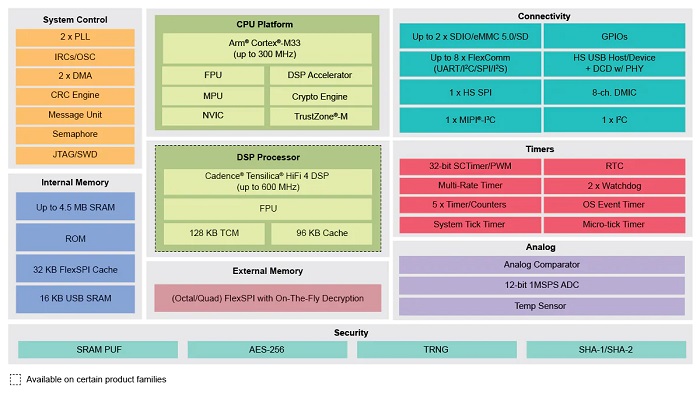By Gina Roos, editor-in-chief
NXP Semiconductors announced production availability of the i.MX RT600 crossover microcontroller (MCU) family. Designed for ultra-low-power, secure edge applications including audio, voice, and machine learning (ML), the crossover MCUs bridge the gap between high performance and integration while meeting cost requirements for embedded processing at the edge.
The i.MX RT600 multi-core crossover processor family features an Arm Cortex-M33 running up to 300 MHz and an optional Cadence Tensilica HiFi 4 audio/voice digital signal processor (DSP) running up to 600 MHz, with four MACS and hardware-based transcendental and activation functions.
Built on a 28-nm FD-SOI process optimized for active and leakage power, the i.MX RT600 supports the high-performance cores with 4.5 MB of on-chip low-leakage SRAM, which has been configured for simultaneous zero-wait state access, making it suited for real-time execution of audio/voice, ML, and neural-network–based applications.
The crossover MCUs also feature EdgeLock, NXP’s advanced embedded security technology, and ML support using the eIQ for Glow neural-network compiler.

Security features include secure boot with immutable hardware “root-of-trust,” SRAM physically unclonable function (PUF)-based unique key storage, certificate-based secure debug authentication, AES-256 and SHA2-256 acceleration, and DICE security standard implementation for secure cloud-to-edge communication. The chip also includes an optional fuse-based root key storage mechanism for secure boot and crypto operations and a public key infrastructure (PKI), or asymmetric cryptography, providing a dedicated asymmetric accelerator for ECC and RSA algorithms.
The crossover processors includes an audio/voice subsystem with support of up to eight DMIC channels, with hardware for voice activation detect (VAD) and up to eight I2 S peripherals. Other peripherals include SDIO for wireless communication, high-speed USB with on-chip PHY, a 12-bit ADC with temperature sensor, and several serial interfaces including 50-Mbits/s SPI, I3 C, and six configurable serial interfaces (USART, SPI, I2 C, or I2 S) with individual FIFO and DMA service request support.
The i.MX RT600 family is supported by the NXP MCUXpresso suite of tools and software. In addition, Cadence’s Xplorer IDE, DSP function libraries, and audio codecs are available for free by developers.
NXP has also partnered with DSP Concepts, Alango Technologies, and Sensory to provide voice pre-processing and recognition software, plus professional audio libraries and tools. The integrated HiFi 4 DSP will be supported with the NXO eIQ for Glow machine-learning compiler, accessible in the next MCUXpresso SDK with a release planned for Q2 2020.
The i.MX RT600 MCU family is available with a suggested resale price starting at $4.50 in quantities of 10,000. An evaluation kit is available at a suggested resale price of $129.
In addition, NXP announced its lead partnership with Arm for the Ethos-U55 microNPU (neural processing unit) machine-learning accelerator. Targeting resource-constrained industrial and IoT edge devices, NXP plans to implement the Ethos U-55 in its Cortex-M–based microcontrollers, crossover MCUs, and real-time subsystems in applications processors.
The highly configurable Ethos-U55 machine-learning accelerator works with the Cortex-M core to achieve a small footprint, delivering greater than 30× improvement in inference performance compared to high-performing MCUs, said NXP. In addition, the chip’s “advanced compression techniques save power and reduce ML model sizes significantly to enable execution of neural networks that previously only ran on larger systems.”
The expansion builds on the company’s ML offerings, including the recently announced i.MX 8M Plus applications processors with a dedicated NPU.
Advertisement
Learn more about Electronic Products Magazine





